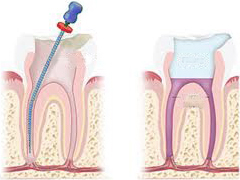Root canal treatment is done when there is extensive dental decay, cavities, that involves the nerve of the tooth. Endodontic therapy is also known as root canal treatment.
 The deep decay/cavity can destroy the nerve and blood vessels of the tooth leading to inflammation, pain and possibility of infection in the form of an abscess. Root canal treatment is a process, which involves removal of dental cavity bacteria, inflamed and necrotic nerve tissue to get rid of the source of infection and pain. Under local anesthesia, the deep cavity is removed, followed be removal of nerve tissue from the nerve canals using rotary files and irrigating solutions. The cleaned up canals are then filled up with a rubbery material called guttapercha to seal the space.
The deep decay/cavity can destroy the nerve and blood vessels of the tooth leading to inflammation, pain and possibility of infection in the form of an abscess. Root canal treatment is a process, which involves removal of dental cavity bacteria, inflamed and necrotic nerve tissue to get rid of the source of infection and pain. Under local anesthesia, the deep cavity is removed, followed be removal of nerve tissue from the nerve canals using rotary files and irrigating solutions. The cleaned up canals are then filled up with a rubbery material called guttapercha to seal the space.
Wikipedia describes root canal treatment as follows: Endodontic therapy or root canal therapy, colloquially root canal, is a sequence of treatment for the pulp of a tooth which results in the elimination of infection and protection of the decontaminated tooth from future microbial invasion. This set of procedures is commonly referred to as a “root canal”. Root canals and their associated pulp chamber are the physical hollows within a tooth that are naturally inhabited by nerve tissue, blood vessels and other cellular entities. Endodontic therapy involves the removal of these structures, the subsequent shaping, cleaning, and decontamination of the hollows with tiny files and irrigating solutions, and the obturation (filling) of the decontaminated canals with an inert filling such as gutta percha and typically a eugenol-based cement. Epoxy resin, which may or may not contain Bisphenol A is employed to bind gutta percha in some root canal procedures.
Root canal treatments are performed to:
- To relieve dental pain
- To treat dental infections related to deep dental decay
- To help save existing teeth
Watch this video from the American Dental Association about endodontic therapy also known as root canal treatment: